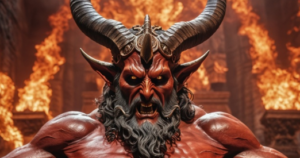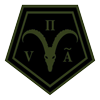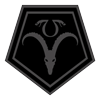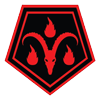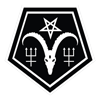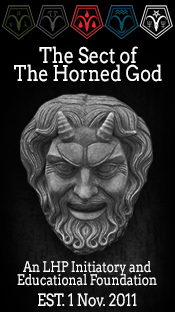Who the Horned God really is
By Thomas LeRoy
“Even if one recognizes the character inversion employed by changing Pan (the good guy), into Satan (the bad guy), why reject an old friend just because he bears a new name and an unjustified stigma?” ~ Anton LaVey
The Horned God represents the primal power of nature, the human as animal, the beast within us all. A beast that should not be ignored. I fully understand that the Horned God from today’s pagan perspective is a 20th-century invention. This version is the consort of the much more important “Goddess”. He is a happy hippie who sits around with bunnies in a meadow, ready to service her.
What I’m referring to when I say “Horned God” is something deeper, something truly ancient. Besides the Sun and Earth, he is perhaps the most primal of gods, not only historically, but psychologically. It is believed that reverence for a Horned God dates back to the Paleolithic. Even though the name of that original horned god etched on a cave wall has been lost to antiquity, his essence lives deep within the human psyche, surviving in the collective unconscious. And that’s what we’re after in the organization The Sect of the Horned God, getting to that core primordial truth, not through faith, but through philosophical, psychological, and historical means. I’ve always been the type that likes to dig deep to discover the core truth behind any given subject. This is reflected in my interest in history, anthropology, genealogy, and so on. And the occult is no different. And with The Sect, I’m daring to cast a wide net in an attempt to pull up more than just the contemporary left-hand path practices. For example, is there a PIE Horned God that connects Cernunnos of the Celts to Pashupati of the Hindus? They look very similar with similar attributes. And why does there seem to be a connection between the LHP and the Horned God archetype? Is this why the Church in the Middle Ages fused the characteristics of the pagan Horned God onto Satan?
“The combination of horned gods, one Celtic (Cernunnos), one classical (Pan), produced a very powerful deity around which the “pagani” rallied. Indeed, so powerful was this god that the Christian priests cast him as the prototype of the Devil . . . ”
~ Georg Luck
The Horned God has been called “The God of the Witches”, “The Consort of the Goddess”, “Guardian of all things untamed”, “Lord of Shadows”, “Master of Darkness”, and the “Devil” by the Church. He is the antithesis of all that the Christians saw as holy for he represents power, lust, carnality, death, and knowledge. And for their dogma to survive and for there to be calm within the flock, the Horned God’s traits in the human character must be subdued. But the early Christians knew that the Horned God was a large part of what a human being is. By telling people that who they are at their core is evil, they created a very effective way of controlling the masses. Thus, they made the Horned God synonymous with the supreme “bad guy” in their mythos.
The Sect of the Horned God was created to bring about a rejuvenation of the Horned God archetype by revealing his many faces as the anthropomorphize primal essence of the LHP. What I’m after, both historically and psychologically, is the core truth of this philosophy. Even though the modern pagan community doesn’t want to admit it, there is a real connection between the Horned God and the LHP, because gods such as Odin and Shiva have horned god roots. In their raw form, these gods were not compassionate father figures. They were gods of wrath that have been around for a very long time, and, as stated, if the past was brutal, then it would have been reflected in mythology. And the foundation, the religious or moral philosophies of any given society, would reflect this fact. That’s what the predominant religion of society does, it establishes a deep, cultural framework, whether we like it or not. So, if you have a barbaric warrior culture, the myths — and the gods that populate those myths — are not going to be ones of compassion, and empathy. Their archetypal motivation would be for the benefit of a specific populace. And for a society to survive in a savage age, then brutality would be the norm. Thus, the “Gods of Wrath” would take center stage.
“But what about Rome?” you may ask, “Didn’t they adopt Christianity as their official religion, and they were brutal?” Yeah, and about 160 years after the adoption of Christianity the Western Roman Empire was no more. There were many reasons for the collapse, but one valid reason was they substituted a master morality for a slave morality. According to Friedrich Nietzsche, the two primary types of morality are master morality and slave morality. Master morality is where “good” and “bad” are equivalent to “noble” and “despicable”. Slave morality’s standards hold to that which is beneficial to the powerless and weak, such as sympathy, kindness, and humility. Thus the strong, confident and even the individualist are evil.
What we know of the Gods of Wrath here in the West is opaque, for the myths and legends of the distant past have been coated with a veneer of Christian slave morality. This being so, it’s somewhat hard to make out the details beneath the surface. An example of this Abrahamic abridgment would be the writings of early 13th-century Icelandic historian and poet, Snorri Sturluson. First off, we should all be thankful to the man for his writings because if he hadn’t done so, we would know very little of the Norse gods. But in his works, he turned the dark god Odin into a quasi-Norse Yahweh. This was because Snorri was a Christian, and it was hard for him to view the gods any other way than by the good/ bad duality. Even though Odin did some horrible things, often directed at the other gods, in Snorri’s eyes, he had to be a good guy. It couldn’t be that the Allfather had a shadow side. The problem with most modern pagans is that they believe these safe versions of the gods are the original versions. They need to do this, censor the gods because the brutal reality of what they were would make them weep.
Well, this brings us back to the Horned God. And if you’re discussing the horned god with a glassy-eyed, tree-hugger the “Goddess” will come up, along with a “Blessed Be”. Neo-pagans see the Goddess as the “Holiest of Holies” while the Horned God has been relegated to the position of Her “boy toy”. This feminized cartoon version of the Horned God co-insides with their white-light beliefs. But, then again, some people are drawn to the ethereal, and if you are and want to get lost in a great cosmic collective filled with unicorns and rainbows, then maybe this safe modern version of the Horned God, and the gods in general, is the thing for you. Grab your tied-dyed moo-moo and bongos and join them, those happy gods are waiting to give you a big fat hug.
But it’s bullshit! And why do I say it is bullshit? Because I know reality isn’t pretty! Maybe the reason I don’t buy into this nonsense is that I have an independent spirit, and an affinity for what some may call the “darker side of life” and would rather disrupt the herd than join it! So, a more truthful, savage representation of the Gods better suits me. And there are many examples of these gods out there, from Rudra to Wotanaz. But even though I may be drawn to the Horned God, I can’t ignore the Goddess. In my eyes she isn’t some vapid being, spreading white light and rainbows. No. She’s the Dark Mother. She is Kali Ma, the ferocious form of the Goddess, represented with what are arguably the most savage features of all the gods. Where Shiva is consciousness, Kali — in the form of Shakti — is energy, the dynamic aspect of Transcendental Reality. In her ferocious form, Kali both creates and destroys, drunk with the paradox that death feeds on life, and life feeds on death. Kali represents that in the East these ancient Indo-European gods were never coated with the veneer of the Abrahamic. Even though there were attempts by the Muslims to do so.
“An approach via the East will disentangle many of the arguments from the sometimes hopelessly confused jumble we find in the historical sources of the left-hand path in the West.”
~ Stephen E. Flowers, PH.D.
Because of their lack of Abrahamist taint, I have incorporated the Eastern gods into my philosophy and that of The Sect. Where here in the West the gods have been watered down, there, in the East, they’re still full strength. I know in India they have some silly pop-culture versions of the gods, but that doesn’t take away what they are culturally, or philosophically. The Hindus know their true nature.
What I want is to acknowledge the gods as they were meant to be, not what those who can’t get over their Christian upbringing wish they were. I want to experience them because that’s what you do, you don’t worship the gods, you experience the gods, and you should experience them in their true nature . . . raw, bloody, and real.
